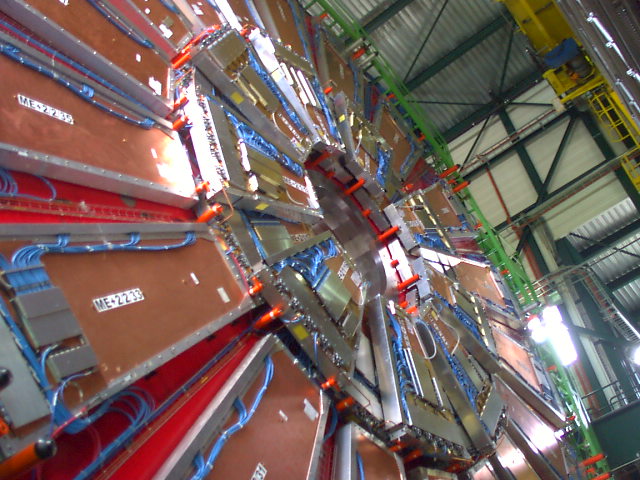

It took the Large Hadron Collider just three years to find the Higgs boson–but it took nearly 20 years to create the Large Hadron Collider. High energy physics happens at the speed of light, but the underlying practicalities move at the speed of bureaucracy, funding requests, and setting concrete. So to keep things moving forward, the global physics community is constantly envisioning and re-envisioning the next big things in high energy particle physics–things big enough to dwarf even the largest and most expensive science experiment mankind has ever created.
Last month at a meeting in Krakow, Poland, we caught a glimpse of these next big things. CERN’S European Strategy Preparatory Group symposium earlier this month collected particle physicists and science policy makers from around Europe and the globe to consider the current and future needs of the physics community and to discuss its many possible futures. Two things seem certain at this point: The LHC isn’t going anywhere just yet, but eventually we’re going to need a bigger, badder replacement for the LHC.
“The LHC will continue to run, and the LHC will continue to be a very, very big part of the particle physics program for the next 15 or 20 years, primarily in finding out more about the Higgs boson,” says Terry Wyatt, a professor of physics at the University of Manchester and an attendee of the strategy symposium. “One of the main points of consensus that emerged from this meeting was that upgrading the LHC to what we’re calling the High Luminosity LHC will take us through 2030 or so.”
These upgrades would include replacing the current LHC accelerator ring magnets with newer, stronger magnets sometime around 2022, essentially creating a more powerful accelerator in the existing LHC footprint. That would allow researchers to continue performing the world’s most advanced physics beneath the Swiss-French border until the end of the next decade. That also means that if physicists want to undertake another experiment as large and ambitious as the LHC and have it ready to start smashing particles by the time the LHC winds down operations around 2030, they really should already be deep into the design phase and preparing to break ground. They’re not; but they’re certainly talking about it. Also up for discussion at the symposium was the question on everyone’s minds: what’s next?
“If you’re serious about having a new accelerator that might start running in 2035, you have to be moving now.”Wyatt is the former leader of the DZero experiment at Fermilab’s Tevatron collider in Illinois and is currently working on the LHC’s ATLAS experiment. He’s also the former chairman of the LHC experiments committee and was a member of CERN’s research board, and currently sits on CERN’s Scientific Policy Committee. That’s another way of saying Wyatt has spent a fair amount of time thinking about the possibilities for high energy particle physics around the world, and at the Krakow strategy session it was Wyatt that presented a talk titled Next Step Facilities. In it, he touched on everything from a proposed 50-mile accelerator ring that would be three times larger than the existing LHC to linear electron-positron colliders and muon smashers–all with the ability to go to far higher collision energies than the LHC. As with physics itself, the possibilities are many–which isn’t necessarily favorable when you’re trying to secure government funding and break ground on multi-decade construction project.
The lack of a clear path forward for the high-energy physics community isn’t simply the result of a lack of funds or of bureaucratic inertia (at least, it’s not only those things). The LHC has just scratched the surface of the Higgs boson, and it has only reached half of its designed maximum collision energy of 14 terra-electronvolts (TeV). The High Luminosity LHC will produce something like ten times more data than its predecessor, and physicists expect that data to yield many new discoveries that will influence the design and concept for the next high-energy particle collider.
That presents a kind of quandary for physicists. To keep particle physics moving seamlessly forward, we need to start building the next-gen collider today. To make sure we build the right next-gen collider, we need more data from the LHC. So in the interim, physicists and engineers postulate, dream, and get to work at their drawing boards.
“The trouble with this is that the time scales for doing any of this are so long that if you’re serious about having a new accelerator that might start running in 2035, you have to be moving now, already, very, very seriously,” Wyatt says. “The technical and engineering challenges–developing these magnets, for instance–is a very, very high-tech thing that takes many, many years. So people are working very seriously right now on technical and engineering challenges that might not actually be used in an accelerator for another 20 years.”
That’s if they’re even used at all. Wyatt likens this process to medieval architects designing and building cathedrals that they knew they would never live to see completed. There’s no telling exactly which of these cathedrals of collision will end up taking high energy physics to the next level. It could be any of them, or something completely different that we have yet to conceive. Click through the gallery link to take a spin through the many possible futures of high energy particle smashing machines as we envision them today. This list is by no means exhaustive, but representative of some of the leading ideas in physics today (and the ones most fascinating to us). If we’ve missed an accelerator/collider concept that you find particularly intriguing, let us know in the comments.





